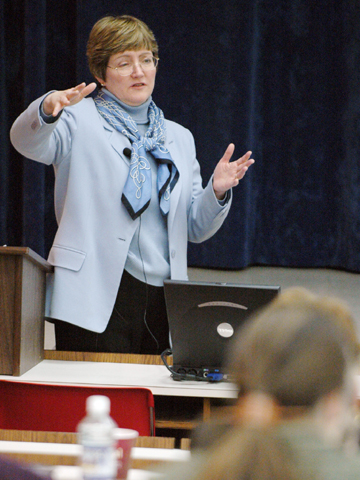| |
|
|

from the issue of February 10, 2005
|

| |
|
|
| |
Communications key to nurturing grad students, new faculty

BY KIM HACHIYA, UNIVERSITY COMMUNICATIONS
Graduate students and early career faculty face some similar challenges as they move forward in their careers, a Michigan State University professor has learned. And similar measures can help both groups succeed as faculty members.


 
| | Ann Austin spoke to a number of faculty groups during her visit. Photo by Brett Hampton.

| |
Ann Austin studies faculty careers, roles and professional development and is co-principal investigator of the Center for the Integration of Research, Teaching and Learning at MSU. She visited UNL Feb. 2-4 and gave a number of workshops with the theme of nurturing future faculty.

Austin said that it's important to focus on early career faculty and graduate students because they are the future of the academy. Some say as many as 40 percent of current faculty will retire in the next decade, and while not all will be replaced, many will be.

Research done by Austin and others show some consistent themes, she said. Early career faculty and graduate students are highly enthusiastic, are excited about working with peers and express desires to impact others and do meaningful work. They also express concerns about the tenure process and about achieving balance between work and family.

Early career faculty also express concerns about the unclear roles, expectations and responsibilities, she said.

Both groups, she said, can be helped by similar strategies that involve communications and personal involvement. And those strategies also need to begin early for grad students or early career faculty members.

Department chairs play a key role for early career faculty, Austin said. Four roles are common.

• The chair as resource person who offers information, links faculty to other colleagues and organizes departmental orientations.

• The chair as mentor, who regularly encourages reflection, helps establish plans, connects colleagues, gives feedback and celebrates progress.

• The chair as institutional representative, who clarifies the university's expectations, explains processes, helps set priorities, monitors assignments and helps secure resources.

• The chair as evaluator who provides regular honest feedback and assessment, encourages departmentwide discussions, provides written records.

All these roles are important, she said, and not every chair is an expert in every role. Assigning these roles to others with that expertise can be helpful, Austin said.

The most important thing, she said, is for chairs to initiate discussions within units about how the unit will nurture and welcome new faculty and graduate students. Those conversations are the first steps to creating environments of success and collegiality, she said.

For graduate students, Austin recommends thorough periodic orientation sessions because the one giant session at the beginning of the semester often occurs during a time when competing demands overwhelm the volume of information being thrown at them.

Efforts to help graduate students and early career faculty connect with a department and learn academic culture also are critical, she said.

Austin acknowledges that her findings have a big "duh" factor. But the fact that grad students and early career faculty report difficulties indicates a need to keep working to improve the workplace, she said.
GO TO: ISSUE OF FEBRUARY 10
NEWS HEADLINES FOR FEBRUARY 10
Communications key to nurturing grad students, new faculty
Dental College providing health care to rural areas
A Piece of University History
NU Press reorganization addresses future
731987S34229X
|
|
|
|
|
|
|
|